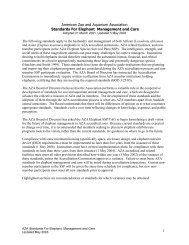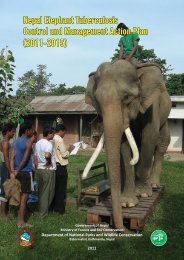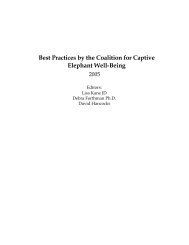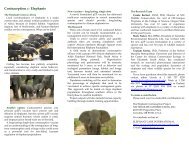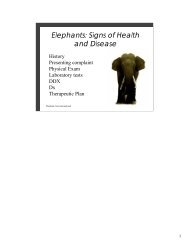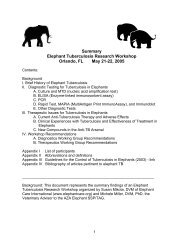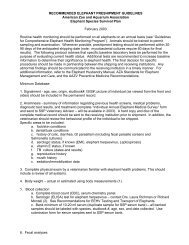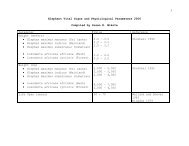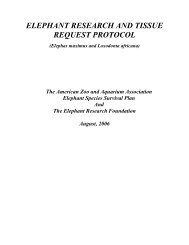Transport Guidelines For Elephants - Elephant Care International
Transport Guidelines For Elephants - Elephant Care International
Transport Guidelines For Elephants - Elephant Care International
You also want an ePaper? Increase the reach of your titles
YUMPU automatically turns print PDFs into web optimized ePapers that Google loves.
TRANSPORT GUIDELINES FOR ELEPHANTS<br />
February 2010<br />
<strong><strong>Elephant</strong>s</strong> can be trained and habituated to transport, with no obvious ill effects. However, zoo<br />
elephants are not routinely transported, and planning for movement should be started well in<br />
advance. <strong>Transport</strong> plans require coordination between elephant handlers familiar with the<br />
individual elephant to be moved, veterinarians and elephant managers at the sending and<br />
receiving institutions, and the contracted transporter; and must comply with local, state, and<br />
federal regulations (United States Department of Agriculture). <strong>For</strong> additional information, refer<br />
to the <strong>Elephant</strong> Husbandry Manual, AZA Standards for <strong>Elephant</strong> Management and <strong>Care</strong>, and<br />
USDA-APHIS Animal Welfare Act.<br />
The following information should be used as general guidelines when conducting an elephant<br />
transport. The final decision for specific procedures should be made in partnership between the<br />
shipping and receiving institutions.<br />
PRIOR TO TRANSPORT<br />
<br />
<br />
<br />
<br />
<br />
<strong>Transport</strong> should be arranged with an individual or company experienced in and properly<br />
equipped for moving an elephant. Contact other institutions for references.<br />
A written transport plan should be developed.<br />
<strong>Elephant</strong> managers and veterinarians from the sending and receiving institutions<br />
should be involved and should agree upon a designee to write the plan.<br />
Plan should detail responsibilities of all parties involved.<br />
Facilities in route should be contacted in advance for assistance with possible<br />
emergencies.<br />
If an elephant will be transported in a trailer, the trailer should be inspected by the sending<br />
institution and meet the following criteria:<br />
Allow the elephant to stand comfortably.<br />
Provide drainage for urine.<br />
Be adequately reinforced and allow the elephant to be safely tethered.<br />
Have adequate heating or cooling systems to maintain the temperature between 55<br />
and 70 degrees F with adequate ventilation; if temperatures will be outside this<br />
range, the elephant should be monitored more frequently.<br />
Permit access for food and water.<br />
Allow handlers to adequately monitor the elephant’s condition.<br />
If an elephant will be transported in a crate, it is best to contact other facilities with<br />
experience in crate design.<br />
<strong><strong>Elephant</strong>s</strong> shipped by airline must meet the guidelines of the <strong>International</strong> Air <strong>Transport</strong><br />
Association (IATA).
Acclimatization to the trailer or crate may take from 1-6 weeks depending on the individual<br />
elephant’s temperament. This process should begin as early as possible before the<br />
transport date. Note: access to the trailer being used for transport may not be feasible if<br />
the institution contracts with a private transporter.<br />
DURING TRANSPORT<br />
<br />
<br />
<br />
<br />
<br />
Handlers familiar with the individual elephant should travel with the elephant to the<br />
receiving institution.<br />
A two week supply of hay and grain should accompany the elephant to the new facility.<br />
This allows a gradual transition to the new diet.<br />
The decision to use sedation or chemical immobilization for transport of an elephant should<br />
be made in advance as part of the written transport plan.<br />
If chemical immobilization or sedation is used to load the animal, the elephant<br />
should be held for up to 24 hours or have a veterinarian accompany the shipment<br />
to avoid complications associated with drug effects.<br />
Personnel accompanying the elephant must be familiar with common side effects<br />
of the drugs and actions needed to prevent or correct complications. Adequate<br />
equipment and supplies should be available.<br />
If the elephant is being transported by airplane, it is strongly recommended that a<br />
veterinarian accompany the elephant. The effects of sedatives or anesthetic drugs<br />
combined with the effects of altitude may potentially lead to more serious side<br />
effects.<br />
Contact SSP Veterinary Advisor for current recommendations regarding sedation<br />
or see AZA <strong>Elephant</strong> Husbandry Manual.<br />
During transport, the elephant should periodically be provided with hay and should be<br />
given access to water if the transport time is greater than 16 hours.<br />
Personnel should regularly monitor the condition of the animal during transport. It is<br />
important that adequate ventilation and temperature control be maintained for the comfort<br />
and well-being of the elephant.<br />
Contact information:<br />
<strong>Elephant</strong> SSP/TAG Veterinary Advisor<br />
Michele Miller, DVM, PhD<br />
Palm Beach Zoo<br />
1301 Summit Blvd.<br />
West Palm Beach, FL 33405<br />
W: 561-833-7130 ext 224; Cell: 561-727-9630; email: mmiller@palmbeachzoo.org<br />
Feb 2010 mm




